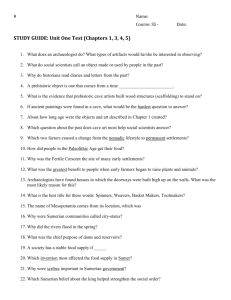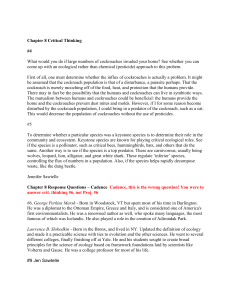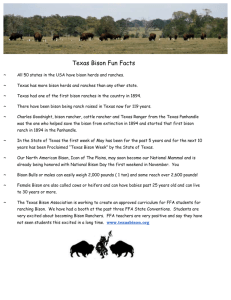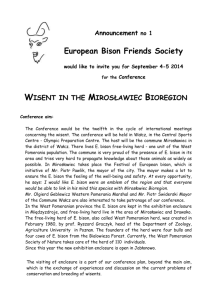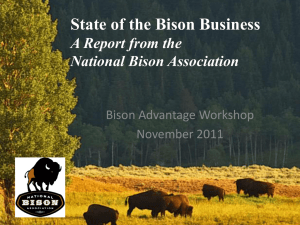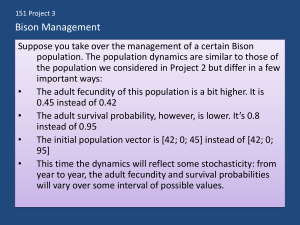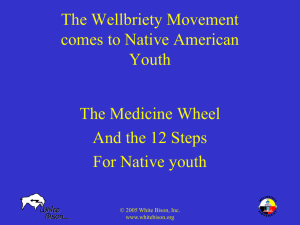Yellowstone Bison Talking Points
advertisement
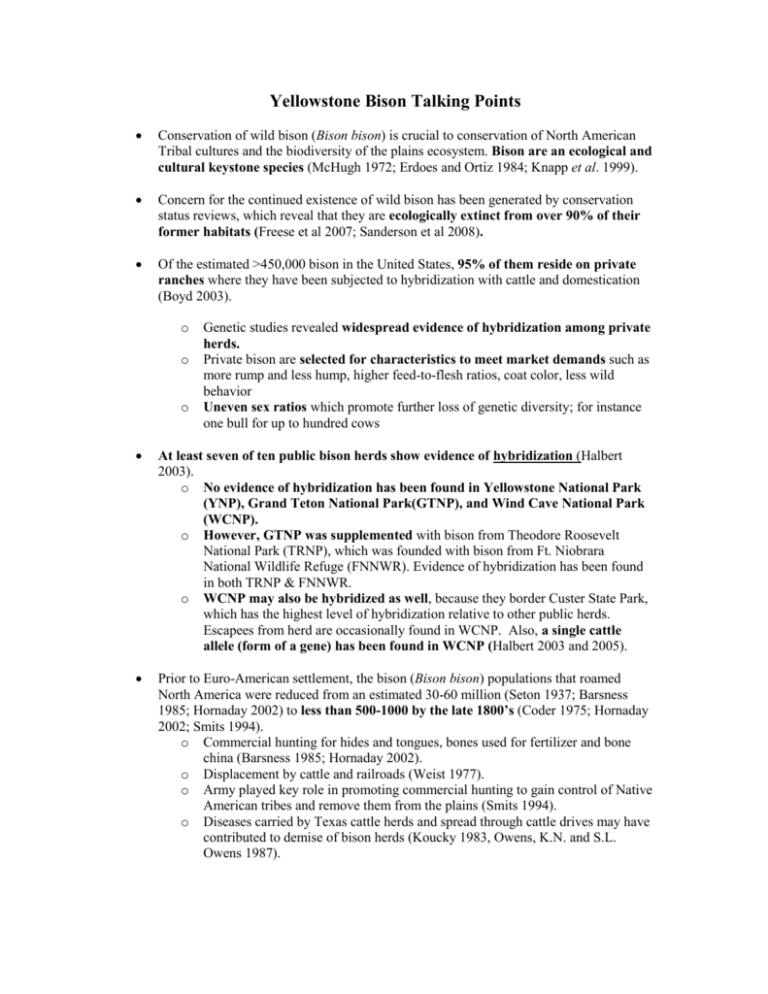
Yellowstone Bison Talking Points Conservation of wild bison (Bison bison) is crucial to conservation of North American Tribal cultures and the biodiversity of the plains ecosystem. Bison are an ecological and cultural keystone species (McHugh 1972; Erdoes and Ortiz 1984; Knapp et al. 1999). Concern for the continued existence of wild bison has been generated by conservation status reviews, which reveal that they are ecologically extinct from over 90% of their former habitats (Freese et al 2007; Sanderson et al 2008). Of the estimated >450,000 bison in the United States, 95% of them reside on private ranches where they have been subjected to hybridization with cattle and domestication (Boyd 2003). o o o Genetic studies revealed widespread evidence of hybridization among private herds. Private bison are selected for characteristics to meet market demands such as more rump and less hump, higher feed-to-flesh ratios, coat color, less wild behavior Uneven sex ratios which promote further loss of genetic diversity; for instance one bull for up to hundred cows At least seven of ten public bison herds show evidence of hybridization (Halbert 2003). o No evidence of hybridization has been found in Yellowstone National Park (YNP), Grand Teton National Park(GTNP), and Wind Cave National Park (WCNP). o However, GTNP was supplemented with bison from Theodore Roosevelt National Park (TRNP), which was founded with bison from Ft. Niobrara National Wildlife Refuge (FNNWR). Evidence of hybridization has been found in both TRNP & FNNWR. o WCNP may also be hybridized as well, because they border Custer State Park, which has the highest level of hybridization relative to other public herds. Escapees from herd are occasionally found in WCNP. Also, a single cattle allele (form of a gene) has been found in WCNP (Halbert 2003 and 2005). Prior to Euro-American settlement, the bison (Bison bison) populations that roamed North America were reduced from an estimated 30-60 million (Seton 1937; Barsness 1985; Hornaday 2002) to less than 500-1000 by the late 1800’s (Coder 1975; Hornaday 2002; Smits 1994). o Commercial hunting for hides and tongues, bones used for fertilizer and bone china (Barsness 1985; Hornaday 2002). o Displacement by cattle and railroads (Weist 1977). o Army played key role in promoting commercial hunting to gain control of Native American tribes and remove them from the plains (Smits 1994). o Diseases carried by Texas cattle herds and spread through cattle drives may have contributed to demise of bison herds (Koucky 1983, Owens, K.N. and S.L. Owens 1987). Shortly after this near extermination, the few remaining bison were either captured and sent to zoos or adopted by private ranchers (Hornaday 2003; Coder 1975). The conservation efforts of the past have insured that the American bison is no longer at risk of demographic extinction. The loss of genetic diversity due to multiple bottlenecks, founder effects, hybridization, and domestication pose the risk of genomic extinction, and reduced evolutionary potential (Freese et al. 2007). o o o o This is the biggest threat to the continued existence of wild bison!!! Bison genes that have evolved through centuries of natural selection are replaced with cattle genes that are not suited for the North American plains ecosystem, potentially reducing fitness of the hybrids. Loss of genetic diversity from population bottlenecks means loss of genes that would allow individuals to survive environmental stresses such as diseases and abrupt changes in weather patterns. The process of domestication selects for specific physical and behavioral characteristics that may have a genetic basis, thereby possibly reducing genetic variation and selecting against other beneficial genes. Individual and collaborative efforts directed at ecological restoration of bison to their former ranges have been initiated by government agencies, private citizens, nongovernmental organizations (NGO’s), and Native American tribes (Freese et al. 2007, in press). o Source populations needed for these efforts! They face two major issues in pursuing these efforts; locating large tracts of suitable habitat for bison, and identifying source populations with sufficient genetic diversity and no evidence of hybridization that can contribute to the conservation of the bison genome (Freese et al. 2007, in press). o YNP is the only population that can qualify as non-hybridized! The YNP bison represent an evolutionary legacy for conservation of bison because they are the only surviving naturally occurring wild bison population. Previous genetic studies revealed that the YNP bison have a relatively high degree of genetic variation and no evidence of hybridization (Ward et al. 1999; Halbert 2003). The disappearance of these populations from the GYA would result in a significant gap in the original range of wild bison (meets an important criteria for listing as a Distinct Population Segment (DPS) under the ESA). The GYA bison may represent an ecological microcosm of historic bison populations, thus requiring careful conservation efforts to ensure their persistence. Further population genetic studies of the YNP, GTNP, and WCNP bison are needed crucial information for agencies charged with the management and conservation of these bison populations. The YNP bison have ecological and historic ranges outside park boundaries within Montana, and movement into these areas is primarily dictated winter conditions and seasonal influences (McHugh 1972, Gates et al. 2005, Cannon 2007). o o o Snow pack levels and mean water content (in spite of population size) is the primary motivation for bison movement out of YNP. Despite low numbers and multiple reductions bison moved out of YNP into Gardiner when winter conditions were harsh (Gates et al. 2005). Poachers slaughtered about 100 bison that shifted westward out of the park in the late winter of 1893-94, a time when bison numbers were low within YNP (McHugh 1972). Since the discovery of brucellosis in 1917 within Yellowstone bison, the herd has experienced several major population reductions to manage the risk of brucellosis transmission to livestock. Many of these culling events occur on winter ranges outside of the park boundaries. o Nearly 4000 bison have been removed from YNP over the last 10 years! If population subdivision exists within YNP, disproportionate culling could adversely affect overall genetic diversity within YNP (Freese et al. 2007, in press). Knowledge regarding population structure is crucial for conservation of natural populations such as the GYA bison, and has important implications for understanding their ecology and evolution (Parsons et al. 2006). Prior genetic studies with microsatellite loci, limited to opportunistic sampling of bison that exited Yellowstone National Park (YNP), suggested the presence of three subpopulations (or breeding groups) within YNP (Halbert 2003). Evidence of more than one breeding group within the park, would require genetic monitoring to be initiated to determine whether there is disproportionate representation of bison from a single breeding group being removed (Gates et al. 2005). Population structure and disproportionate culling would also necessitate the development of alternative interagency management regimes that would mitigate the potential loss of genetic diversity. Literature cited: Barsness, L. 1985. Heads, Hides, and Horns; The Compleat Buffalo Book. Texas Christian University Press, Fort Worth, Texas. Boyd, D.P. 2003. Conservation of North American bison: status and recommendations. Masters Thesis, University of Calgary, Calgary, Alberta, Canada. Cannon, K.P. 2007. Biogeography of Holocene bison in the Greater Yellowstone ecosystem. Dissertation, University if Nebraska, Lincoln, Nebraska. Coder, G. D. 1975. The national movement to preserve the American buffalo in the United States and Canada between 1880 and 1920. Ph.D. dissertation, Ohio State University. Erdoes, R. and A. Ortiz. 1984. American Indian Myths and Legends. Pantheon books, New York, New York. Freese,C.H., K.E. Aune, D.P. Boyd, J.N. Derr, S.C. Forrest, C. C. Gates, P.J. Gogan, S.M. Grassel, N.D, Halbert, K. Kunkel, and K.H. Redford. 2007. Second chance for plains bison. Biological Conservation, Article in Press. Gates, C.C., B. Stelfox, T. Muhly, T. Chowns, and R.J. Hudson. 2005. The Ecology of Bison Movements and Distribution In and Beyond Yellowstone National Park. Faculty of Environmental Design, The University of Calgary, Calgary, Alberta. Halbert, N.D. 2003. The utilization of genetic markers to resolve modern management issues in historic bison populations: implications for species conservation. Ph.D. dissertation, Texas A&M University, College Station, Texas. Halbert, N.D., T.J. Ward, R.D. Schnabel, J.F. Taylor,, and J.N. Derr. 2005. Conservation genomics: disequilibrium mapping of domestic cattle chromosomal segments in North American bison populations. Hornaday, W.T. 2002. The Extermination of the American Bison. Smithsonian Institute Press, Washington and London. Knapp, A.K., J.M. Blair, J.M. Briggs, S.L. Collins, D.C. Hartnett, L.C. Johnson, and E.G. Towne. 1999. The keystone role of bison in North American tallgrass prairie. BioScience 49(1): 39-50. Koucky, R.W. 1983. The Buffalo disaster of 1882. North Dakota History 50: 23-30. McHugh, T. 1972. The Time of the Buffalo. University of Nebraska Press, Lincoln, Nebraska. Meagher, M.M. 1973. The bison of Yellowstone National Park. National Park Service Science Monologue 1: 1-161. Owens, K.N. and S.L. Owens. 1987. Buffalo and bacteria. Montana; The Magazine of Western History 37: 65-67. Polziehn, R.O., C. Strobeck, J. Sheraton, R. Beech, J. 1995. Bovine mtDNA discovered in North American bison populations. Conservation Biology 9: 1638-1643 Polziehn, R.O., R. Beech, J. Sheraton, and C. Strobeck. 1996. Genetic relationships among North American bison populations. Canadian Journal of Zoology 74: 738-749. Sanderson, E.W. et al. 2008. The ecological future of the North American bison: Conceiving long-term, large-scale conservation of wildlife. Conservation Biology 22: 252-266. Smits, D.D. 1994. The frontier army and the destruction of the buffalo: 1865-1883. The Western Historical Quarterly 25(3): 312-338. Seton, E.T. 1937. Lives of Game Animals. Literary Guild of America, New York. United States Department of the Interior, National Park Service. 2000. Bison Management for the State of Montana and Yellowstone National Park; Final Environmental Impact Statement. U.S. Government Printing Office, Region 10. Ward, T.J., J.P. Bielawski, S.K. Davis, J.W. Templeton, and J.N. Derr. 1999. Identification of domestic cattle hybrids in wild cattle and bison species: a general approach using mtDNA markers and the parametric bootstrap. Animal Conservation 2: 51-57. Weist, T. 1977. A History of the Cheyenne People. Montana Council for Indian Education; pp.43.


